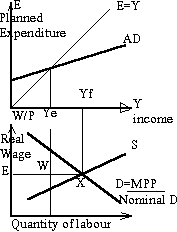

Amount of money does not matter, aggregate demand can be anything with given amount of money, the velocity of circulation can be whatever, if people do not want to spend, then extra money will be held in accounts.
Amount of money does matter, if people are in equilibrium they have some money in bank accounts, thus extra money will be spent. Founded by M. Friedeman in 1956. MF argued that the depression of 1930 was caused by massive contraction of the money supply and not by lack of investment as Keynes had argued.
States that money changes only nominal but not real prices, because M is constant (gold mined etc.) and V and T are constant in MxV=PxT(Fisher's equation).
Quantity theorists - V depends on how often you are paid. Higher level of spending requires higher V.
T includes also the purchase of intermediate goods, thus the real equation should be: MxV=PxY where Y is the level of output (real income).
The more people save the less is V. Demand for money(Md)= k(constant, proportion of national income demanded in money)x(PxY)(money income). In the economy M=Md. If amount of money(M)>Md, then additional expenditure will occur rising Md. The equation can be written Mx=PxY. They thought that money is only for transactions, thus k = constant. Keynes explained that later more throughly.
V is volatile. People hold money not only for transactions, but as a storage of wealth. People can choose between real (car, house) and financial (money, bonds) assets. Holding money increases certainity and holding bonds gives income.
-Relates to the money determined by quantity theorists. It's smaller when income is paid weekly and bigger when income is paid monthly. Determined by income. Interest inelastic.
Against unexpected things. Depends on income and lifestyle. Quite income inelastic.
Breaks the quantity theory, interest elastic. If interest low people hold money (because bond prices are high and relatively little oportunity cost) and vice-versa.
Big increase in money supply (perfectly inelastic, because state controls) causes relatively small decrease in interest rates, causes relatively small increase in investment, causes income and expnditure to rise a bit (thus finally a rise in agregate demand). (p538 graph). Note:
1. The link between money S and aggregate demand is inderct (through I)
2. Keynesians thought demand for money is interest elastic, thus the quantity of money supply increase is absorbed and the interest rate will change insignificantly compared to expetations.
3. Investment is inelastic, thus increases a little only.
4. Both the demands for money and investment are likely to be highly volatile because of expetations. Thus Keynesians do not think rising of money S helps and believe in fiscal policy. Also the Banks have liquid reserves, thus the money supply increase is shielded.
Increase in money supply causes a big fall in interest rates and thus an increase in investment, which increases income. National income is also boosted directly by fall of interest rates because people by more durable goods (houses) (p.540 graph) Note:
1. There are also direct effects (cash balance effect) besides the effect of increased I.
2. Demand for money is I inelastic
3. Investment is interest elastic.
View: If fiscal policy is unaccompanied by monetary it has weak effects. Injections will crowd out private sector rather than increase the agregate demand. Monetarists don't believe V is always constant, hence policy is not suitable for fine-tuning the economy. The rate of money supply should increase with the growth of economy, then there is no inflation.
Keynesian: Economy is like organism, when ill should be cured, if some unemployment exists the increased Gov. expenditure would result in rise of the real income.
Monetarist: Organism is strong enough to survive and "doctors" can only make the thing worse. Increase in demand will lead to only increase in nominal income.
Monetarists do not make great difference between micro-and macro economics and they think the supply f individual firms and markets also id for the whole nation. They view the equation W = MPP x P (or MRP) as W/P=MPP where W/P is the actual purchasing power. We have to include weighting (as in RPI) because not all goods are equally important. Aggregate production function - as no. of workers rises the MPP will fall. This function eliminates money (neo-classical view), because wage is measured by real wage not including prices and demand by MPP not by amount of wage has to be paid. Thus government can't affect MPP and thus not the unemployment.

Unemployment of WX occurs at wage E although economy is in equilibrium at Ye.
Use the term natural rate on employment to show that without the Gov. every worker will do their best and equilibrium occurs. They also believe that in the short run the equilibrium of the labour market also sets the level of output or aggregate supply. Natural rate will increase as capital stock increases. If there is unemployment wages will be cut and more people will be employed. There is voluntary and involuntary unemployment. Pure monetarists argue that all unemployment is voluntary as people are receiving social benefits and do not want to go to low-paid work. This type of unemployment cannot be changed by changing aggregate demand, but the markets must be made to work better (retraining schemes, helping to change departments etc.)
Keynesians believe that the speed the market forces work is too slow. If the demand is low, then the wages are not cut, but the quantity produced is decreased and some people are fired (because wages are "downward sticky" and there are usually trade unions). Furthermore, if wage is lowered it will result in a decrease in demand and even further unemployment.